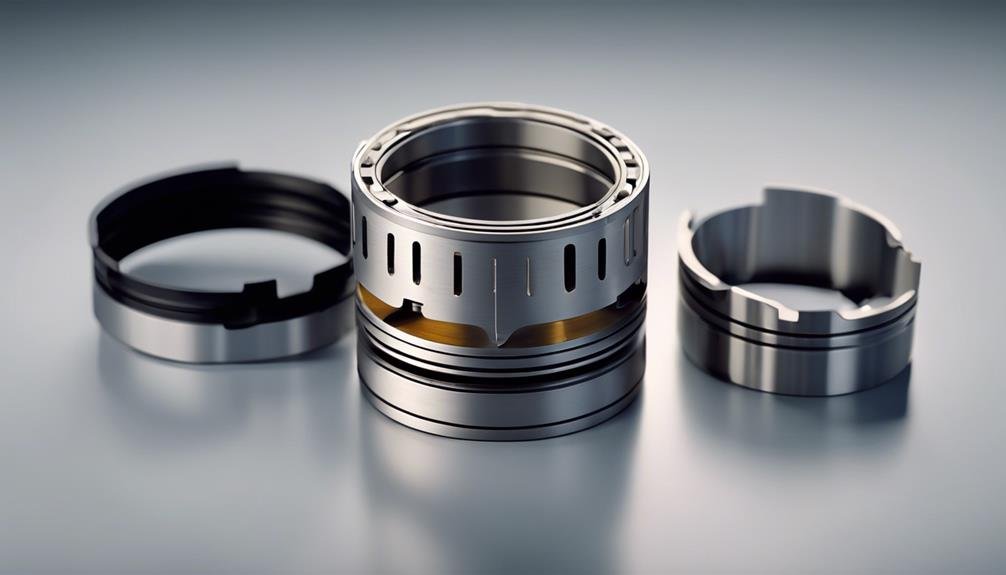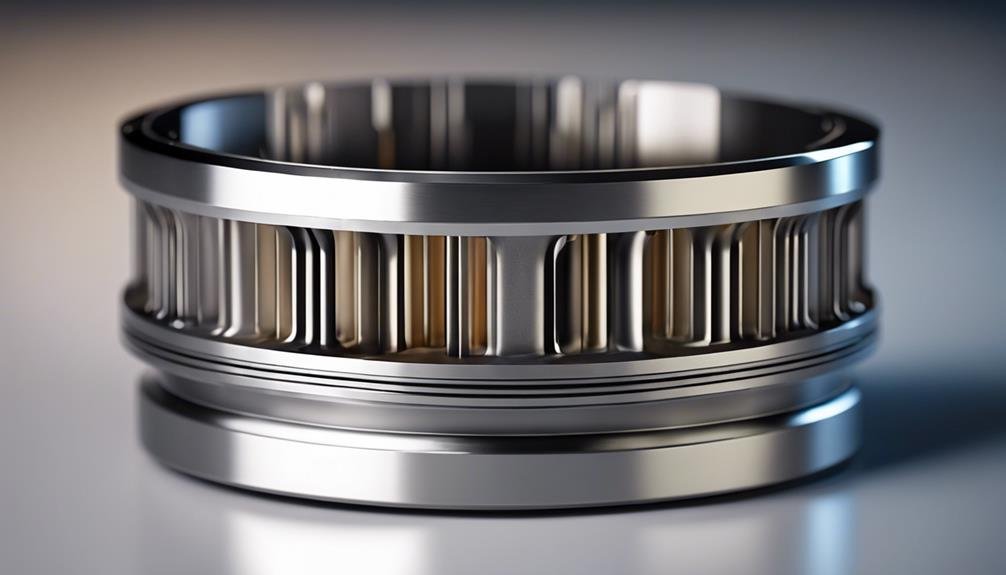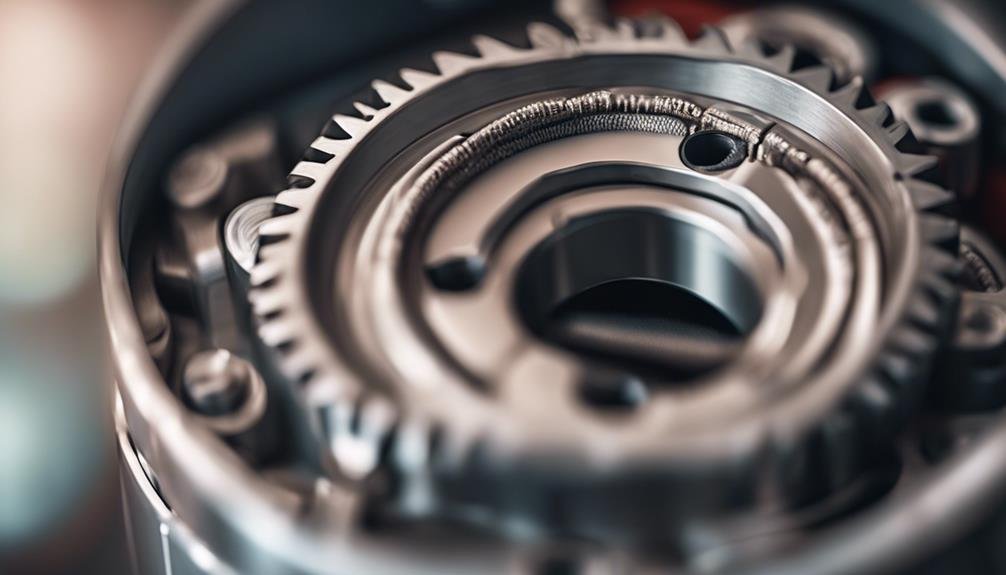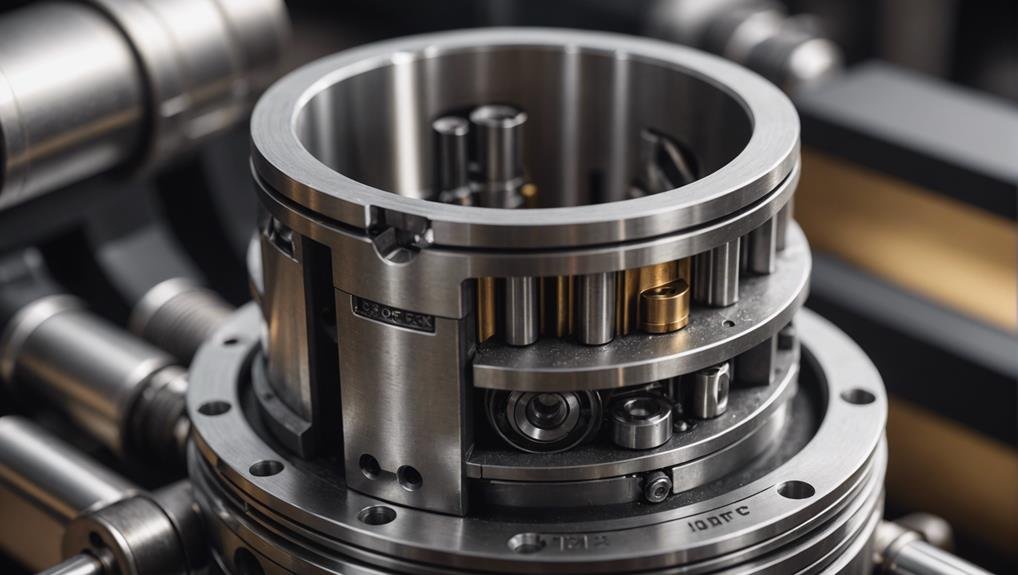As you investigate the intricate workings of an internal combustion engine, the piston stands out as an essential component, transferring energy from expanding gases to the connecting rod while enduring extreme temperatures and pressures during combustion. The piston's design involves a delicate balance of strength, heat resistance, and weight, often utilizing aluminum alloys for their high thermal conductivity and excellent strength-to-weight ratio. The piston rings and pins play vital roles in sealing the combustion chamber, regulating oil consumption, and connecting the piston to the connecting rod. Now, uncover the intricate details of piston skirts, bearing surfaces, and connecting rods, and reveal how these key components work together to optimize engine performance.
Key Takeaways
- The piston is a critical engine component that transfers energy from expanding gases to the connecting rod, enduring extreme temperatures and pressures.
- Piston material and design must balance strength, heat resistance, and weight, with aluminum alloys providing a lightweight and high thermal conductivity solution.
- Piston rings and pins play a crucial role in sealing the combustion chamber, regulating oil consumption, and withstanding high mechanical stress.
- The connecting rod transfers motion from the piston to the crankshaft, converting linear motion to rotational force, and is crafted from strong materials like steel or aluminum alloy.
- The piston skirt ensures proper alignment within the cylinder bore, promotes smooth piston movement, and minimizes friction against cylinder walls for improved efficiency.
What Is a Piston?
As you investigate the inner workings of an engine, you'll find that a piston is a critical component that moves up and down within the cylinder, playing an important role in the combustion process. This cylindrical piece, typically made from an aluminum alloy, features piston rings that guarantee proper sealing.
The piston's primary function is to transfer energy from expanding gases to the connecting rod, which then moves the crankshaft. During combustion, the piston endures extreme temperatures and pressures, making it an essential component in the engine's operation.
The piston's design, materials, and functionality directly impact the engine's performance and efficiency. To achieve best compression, the piston must be precisely engineered to withstand the intense forces generated during combustion. By understanding the piston's role, you'll gain insight into the intricate mechanisms that power your vehicle.
Piston Material Selection
When designing an engine, you need to accurately choose the piston material to guarantee peak performance, efficiency, and durability, as the critical choice can lead to compromised engine operation.
One essential aspect of piston material selection is balancing strength, heat resistance, and weight considerations.
Here are four key benefits of using aluminum alloys for piston applications:
- Lightweight properties: Aluminum alloys reduce reciprocating mass, improving engine efficiency and performance.
- High thermal conductivity: Aluminum alloys efficiently dissipate heat, ensuring ideal engine operation in high-temperature environments.
- Excellent strength-to-weight ratio: Aluminum alloys provide exceptional strength while minimizing weight, making them ideal for piston applications.
- Enhanced durability: Advanced aluminum alloys withstand high pressures and temperatures, ensuring reliable engine operation.
Understanding Piston Rings

You'll find piston rings playing an important role in sealing the combustion chamber, regulating oil consumption, and facilitating heat transfer within the engine. These rings are critical components that guarantee engine efficiency and performance. There are three primary types of piston rings: compression rings, wiper rings, and oil control rings. Compression rings seal the combustion chamber, preventing gas leakage, while wiper rings remove excess oil from the cylinder walls. Oil control rings regulate oil consumption, maintaining the ideal amount for engine lubrication.
| Type of Piston Ring | Function |
|---|---|
| Compression Ring | Seal the combustion chamber |
| Wiper Ring | Remove excess oil from cylinder walls |
| Oil Control Ring | Regulate oil consumption |
Piston rings are typically made from durable materials like alloy steel or duralumin, ensuring their longevity and effectiveness. Proper installation of piston rings is vital for engine efficiency and performance. By understanding the role of piston rings, you'll appreciate their significance in maintaining a well-functioning engine.
The Role of Piston Pins
Piston pins play an important role in connecting the small end of the connecting rod to the piston, enabling smooth movement and precision engine operation. As you explore the intricacies of piston pins, you'll find that they're typically made of case-hardened steel, which provides exceptional strength and durability. Additionally, their hollow design reduces weight, allowing for improved engine performance.
Here are some key aspects of piston pins:
- Material: Case-hardened steel for strength and durability
- Design: Hollow to reduce weight and boost performance
- Configurations: Set screw, semi-floating, and fully floating types
- Fastening: Set screws or clamp screws ensure a secure connection
The design of piston pins is critical for withstanding high mechanical stress and maintaining smooth engine operation. By understanding the importance of piston pins, you'll appreciate the intricate details that go into creating a high-performance engine.
With proper fastening methods, you can guarantee a secure connection between the piston and connecting rod, ultimately leading to a more efficient and reliable engine.
Connecting Rod Functionality

As the piston moves up and down, the connecting rod plays an important role in transferring that motion to the crankshaft, converting linear energy into rotational force.
You see, the connecting rod serves as a key link between the piston and the crankshaft in an engine, and it's responsible for converting the linear motion of the piston into the rotational motion of the crankshaft.
To withstand the high mechanical stress involved in this process, connecting rods are typically crafted from strong materials like steel or aluminum alloy.
The connecting rod consists of several components, including the big end, small end, shank, and cap, all working together to ensure efficient functionality.
When designing a connecting rod, engineers must balance strength with weight to achieve optimal engine performance.
By doing so, they can create a reliable and efficient engine that enhances power output while minimizing weight.
As you can see, the connecting rod plays a crucial role in the engine's operation, and its design requires careful consideration of different factors to achieve excellent results.
Piston Skirt Design Importance
While the connecting rod plays an essential role in converting linear motion into rotational force, the piston skirt's design is just as vital, as it guarantees proper alignment within the cylinder bore and facilitates smooth piston movement.
As you explore further into the piston's internal workings, you'll find that the piston skirt's design has a significant impact on engine performance and reliability.
Here are some key aspects of piston skirt design:
- Alignment: The piston skirt ensures proper alignment within the cylinder bore, reducing piston rocking and promoting smooth movement.
- Stability: Different skirt designs, such as full skirt and slipper skirt, offer stability and reduce piston rocking.
- High-temperature performance: The piston skirt prevents binding in high temperatures, ensuring smooth piston movement even under extreme conditions.
- Friction reduction: A well-designed piston skirt minimizes friction against the cylinder walls, contributing to improved engine efficiency and reliability.
Bearing Surfaces Explained

You'll find that the bearing surfaces, where the piston meets the cylinder walls, play a vital role in facilitating smooth movement and minimizing friction.
These surfaces, where the piston and cylinder walls interact, are important for reducing wear and friction between the two components.
Proper lubrication of the bearing surfaces is necessary to prevent overheating and damage, ensuring the engine operates within a safe temperature range.
The quality and condition of the bearing surfaces have a direct impact on the general performance and longevity of the engine.
As you inspect and maintain your engine, pay close attention to the bearing surfaces, as they require regular maintenance to ensure efficient engine function.
Failure to do so can lead to premature wear, overheating, and damage, resulting in costly repairs.
Through regular inspection and maintenance, you can extend the life of your engine and prevent damage caused by wear and friction.
Key Components in Action
Inside the piston, several key components work together in harmony to facilitate the combustion process, with each part playing an essential role in the engine's overall efficiency.
As you visualize the inner workings of the piston, consider the following critical components in action:
- Piston head: Endures extreme temperatures and pressures within the combustion chamber.
- Piston skirt: Provides stability and alignment within the cylinder bore.
- Piston rings: Seal the combustion chamber, regulate oil consumption, and aid in heat transfer.
- Piston pin: Connects the piston to the connecting rod, allowing for movement.
These components work in concert to optimize engine performance.
The piston head, subjected to intense combustion forces, transfers energy to the connecting rod via the piston pin.
Meanwhile, the piston skirt ensures smooth movement within the cylinder bore, while the piston rings maintain a tight seal to regulate oil consumption and facilitate heat transfer.
As you explore further into the intricacies of the piston, it becomes clear that each component plays a crucial role in maintaining top-notch engine performance.
Frequently Asked Questions
What Are the 5 Parts of a Piston?
You're wondering what makes up a piston, right? Well, you've got five key parts: the piston head, skirt, rings, pin, and connecting rod, all working together to keep your engine running smoothly!
What Are the Rings on a Piston For?
You're wondering what the rings on a piston are for? Well, they're essential for sealing the combustion chamber, controlling oil consumption, and assisting heat transfer, ensuring peak engine performance and minimized emissions.
What Is Inside a Piston?
You're wondering what's inside a piston? Well, it's not hollow! You'll find a piston pin connecting it to the connecting rod, allowing the piston to move up and down smoothly inside the cylinder bore.
What Are the Holes in a Piston?
You're wondering what those holes in a piston are? Well, they're called piston pin bores, and they're designed to house the piston pin, connecting the piston to the connecting rod, allowing for smooth movement within the cylinder.
Conclusion
Now that you've examined the inner workings of a piston, you've gained a deeper understanding of the intricate components that work together in harmony.
From the carefully selected materials to the precise design of piston rings, pins, and skirts, each element plays a crucial role in the engine's efficiency and performance.
By grasping the functions of bearing surfaces, connecting rods, and key components, you're better equipped to appreciate the remarkable complexity of a well-crafted piston.
